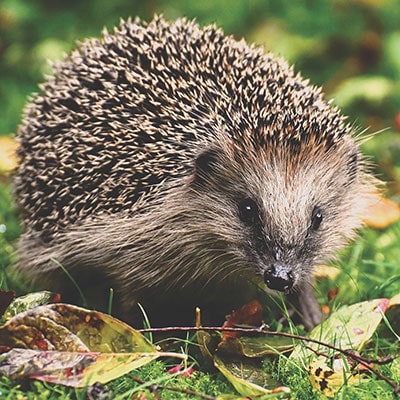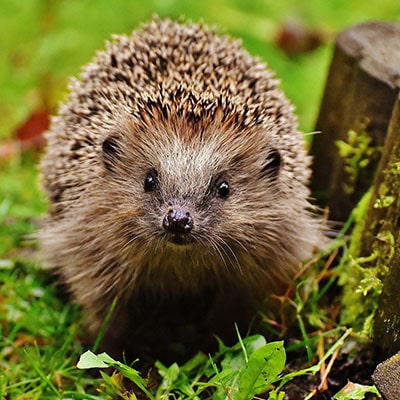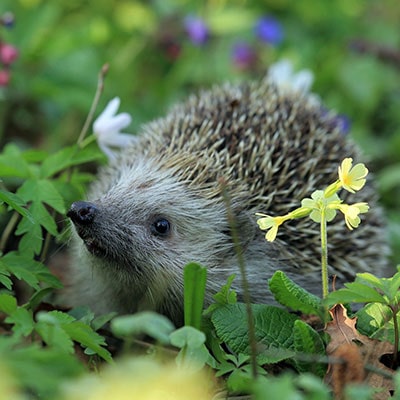
The hedgehog is one of the most familiar of Britain’s wild animals. Known as ‘the gardener’s friend’ for their love of feasting on those pesky worms and slugs, hedgehogs can be spotted roaming our gardens at night but sadly the number of them in the UK is rapidly decreasing. So what’s happening to the hedgehog population?
Why hedgehogs need help:
Hedgehogs once thrived in the UK - in the 1950’s there were over 30 million of our spikey friends - but now this figure has dropped to less than a million.
The most significant reason behind the drop in numbers is the result of the loss of their natural habitat in Britain. The increase in population and the need for more housing is a concern. Hedgehogs need somewhere to shelter, hibernate and raise their young and hedges are the perfect place for this. They provide easy access in and out of a garden and, with leaves gathering at the bottom, it makes the perfect and cosy hedgehog hideaway. Yet sadly there is a decline in these spaces as well as access to gardens.
Hedgehogs need to forage for food and, without access to gardens, this can be a struggle. The rise in housing and solid garden structures such as concrete fencing, patios and decking means access to gardens is reduced. Gardens are fenced off so hedgehogs can’t travel freely and their space for hunting for food is greatly reduced.
Neat and tidy gardens are also useless to hedgehogs - they tend to make their nests in hedges, compost heaps or just a pile of old leaves and twigs so a perfectly tidy garden doesn’t offer them much protection.
Hedgehogs are under threat in both the countryside and in towns. If we look at modern farming techniques, more and more chemical treatments are being used which results in a lack of macro-invertebrates such as worms, beetles, caterpillars and slugs – that's a hedgehog’s main diet all being killed off.

How we can help hedgehogs:
There are a few simple things we can do in our garden to help the hedgehogs:
Habitat and access:
Hedgehogs need to travel between gardens in search of food, so with a fenced-off garden they can’t get in! The simplest solution is to cut a small hole, only 12 – 15cm across at the bottom of your fence or gate, and encourage your neighbours to do the same. This then allows access into your garden and creates a hedgehog highway which provides a larger area to forage for food, find a mate and raise their young. You can download advice and how to do this here.
As well as hedges, a compost heap is another favourite nesting spot for hedgehogs. Always approach your heap carefully when depositing waste and especially when turning with a fork - this could cause major harm to a hedgehog who may be hibernating inside. It is best to turn or empty the heap in April which is after they have finished hibernating and before they start breeding.
Another ideal nesting spot for a hedgehog is a simple pile of twigs and leaves. This can be positioned behind your shed or in a quiet and undisturbed corner of your garden.
Feeding:
As we mentioned before, a hedgehog’s natural diet consists of beetles, caterpillars, slugs and worms. However, additional food can be a big help, especially before and after hibernation season as they will need to gain weight. Meat-based dog food is great (ideally chicken or turkey flavour) but avoid fish or anything in gravy. Also, make sure to never leave out milk and bread as these can make for a poorly hedgehog.
Don’t forget about water too. Fresh water can be a saviour to hedgehogs, especially during the warm weather!
How about trying a feeding station? This can be a great way to provide our spikey friends with their tasty food whilst making sure other animals don’t steal it (if you're lucky you may even be able to catch a glimpse of the hedgehogs enjoying it!). Use a plastic box and cut a 5-inch hole on one side and cover the edges with tape to hide those nasty rough edges and protect the hedgehog when entering and exiting. Place the food in a dish at the opposite end of the box so any cats can’t reach it with their paws! Don’t forget to add the water bowl too. It’s a good idea to place the feeding station very near to a hedge or fence so only the hedgehogs can get in. Make sure to also put something heavy on the top so it stays in place!
Other hazards:
It’s also important to avoid harming hedgehogs too…
Although they can be great swimmers, deep ponds can be hazardous to hedgehogs as they can fall in and struggle get out due to the steep sides. A pond with gentle sloping sides is ideal, or you can place bricks at the side of the pond to create a ramp to give them an easy route out. If you’re lucky enough to have a swimming pool in your garden, make sure to cover it overnight and whenever it's not in use.
Remove sports or fruit netting when not in use. It's also best to remove any barbed wire and other wires to prevent hedgehogs becoming entangled and getting injured.
Say no to slug pellets as these can make hedgehogs ill. Plus, our spikey should do the work for you as they can hoover up over 100 invertebrates every night!
Always check for hedgehogs before using strimmers and mowers, particularly around hedges, long grass and other known nesting spots.
Hedgehogs have poor eye sight, especially during daylight. They are still curious little critters though, meaning they can often fall into holes and get stuck. Cover up open drains and gullies to prevent this.
Bonfires can be disastrous to hedgehogs - every year during bonfire season large numbers of hedgehogs die or suffer injuries due to bonfires not being checked before being lit. It is recommended to build bonfires as close to the time of lighting as possible as these can become the ideal spot for hedgehogs to take residence during hibernation. Also, always remember to check them thoroughly before lighting.
Hedgehog-friendly gardening:
All you need to do is be a little bit untidy. Hedgehogs need a place to shelter, so that big pile of leaves and branches may be the perfect haven for them. These sweet critters just want a quiet space so keep that in mind when looking after your garden.

Introducing hedgehogs to your garden can be massively rewarding. Not only should they keep your slug problem at bay, but on a light and quiet evening you may be rewarded with the sound of a hedgehogs sniffling snout. You can even use a torch covered with red gel tape so not to disturb them during dark evenings - it's a great way to get a closer look and enjoy those night time viewings. Although hedgehogs may not stay loyal to you, you can rest assured that you have done your bit to create a garden which is safe and allows the hedgehog community to thrive.
If you'd like to find out more about hedgehogs, please take a few moments to read DIY Garden's 'The Ultimate Guide to Looking After Hedgehogs'.
